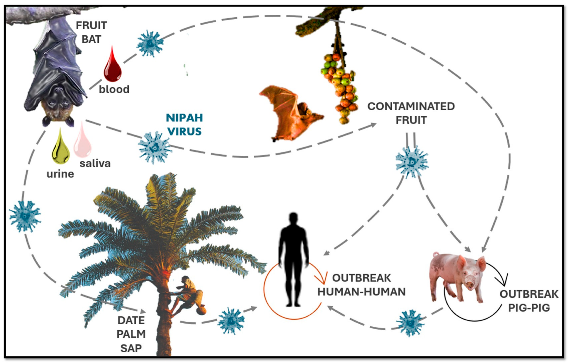Nipah Virus

- 08 Jul 2025
In News:
The Kerala government has initiated a serological surveillance programme in response to the recurrent outbreaks of the Nipah virus (NiV) in the northern districts of the state. Notably, this marks the eighth outbreak in as many years within Kerala’s high-risk zones.
About Nipah Virus (NiV):
What is Nipah Virus?
- Zoonotic Nature: The Nipah virus is a highly infectious zoonotic pathogen, transmitted primarily from animals (especially bats) to humans.
- It can cause illnesses ranging from mild flu-like symptoms to fatal brain inflammation (encephalitis).
- Case Fatality Rate: Ranges between 40% and 75%, depending on healthcare accessibility and regional factors.
History of Outbreaks:
|
Country |
Outbreak Details |
|
Malaysia |
First outbreak recorded in 1999 among pig farmers. |
|
Bangladesh |
Repeated annual outbreaks since 2001. |
|
India |
Significant outbreaks in West Bengal (Siliguri) and Kerala (8 episodes since 2018). |
Reservoir and Transmission:
Natural Host:
- Fruit bats of the Pteropodidae family (genus Pteropus) are the natural reservoirs.
- The virus is shed through bat saliva, urine, and feces, often contaminating fruits or surfaces.
Modes of Transmission:
- Animal to Human:
- Direct contact with infected animals (especially pigs or bats).
- Consumption of contaminated items like raw date palm sap or fruit.
- Human to Human:
- Close contact with infected persons, especially bodily fluids.
- High risk in hospital settings among caregivers and healthcare workers.
Symptoms and Disease Progression:
- Initial Symptoms: Fever, headache, sore throat, muscle pain, and vomiting.
- Advanced Cases: Severe respiratory issues, seizures, encephalitis, and altered mental status.
- Incubation Period: Typically 4–14 days, may extend up to 45 days.
- Post-recovery Complications: Around 20% of survivors may suffer long-term neurological effects such as personality changes or seizures.
Diagnostic Tools:
- RT-PCR: Detects viral RNA in blood, urine, throat swabs, or cerebrospinal fluid.
- ELISA: Identifies presence of NiV-specific antibodies.
- Advanced Virology Labs: Use virus isolation and genome sequencing methods.
Kerala’s Serological Surveillance Initiative:
- The state has launched a targeted serological survey using pseudovirus neutralization assays.
- The survey focuses on human and domestic animal populations living near previously identified Nipah hotspots.
- Objectives:
- Track antibody prevalence in high-risk populations.
- Understand spillover mechanisms from animal to human.
- Identify potential animal reservoirs and transmission routes.
- Enhance early warning capabilities to prevent future outbreaks.
Nipah Virus (The Hindu)
- 13 Sep 2023
What is the News ?
The Kerala health department sent out a warning in Kozhikode because they suspected that two individuals who passed away from unusual causes in the district might have contracted the Nipah virus (NiV).
Facts About:
Nipah virus infection is an illness that can be passed from animals to humans.
- The virus responsible for Nipah Virus encephalitis is an RNA virus belonging to the Paramyxoviridae family and Henipavirus genus.
- It is closely related to the Hendra virus.
This virus first emerged in Malaysia and Singapore in 1998 and 1999.
- Initially, it was detected in domestic pigs but has since been found in various domestic animals, including dogs, cats, goats, horses, and sheep.
Transmission:
The disease is transmitted through fruit bats, often referred to as 'flying foxes,' specifically those belonging to the Pteropus genus.
- These bats are natural hosts for both Nipah and Hendra viruses.
- The virus is present in bat urine and, potentially, in bat feces, saliva, and birthing fluids.
Symptoms:
- Typically, when humans become infected, they experience symptoms resembling encephalitis, which include fever, headaches, drowsiness, confusion, disorientation, coma, and sometimes even death.
Treatment: Currently, there is no specific treatment available for this virus.
